Geology Reference
In-Depth Information
You already know that the term
rock
applies to solid aggre-
gates of minerals, mineral-like matter as in obsidian, and
masses of altered organic matter such as coal. In Chapter 1,
we also briefly defined the three main families of rocks—
igneous, sedimentary, and metamorphic (see Figure 1.15).
Our concern in this chapter is with igneous rocks, that is,
rocks that formed from molten rock matter (magma) that
cooled and crystallized to form minerals, and rocks made
up of particulate matter ejected during explosive volcanic
eruptions. We are most familiar with eruptions of lava and
particulate matter from volcanoes because they can be ob-
served. And yet, most magma never reaches Earth's sur-
face, but rather cools and crystallizes underground, thus
forming several types of igneous rock bodies that geolo-
gists call
plutons
, named for Pluto, the Roman god of the
underworld.
Granite, composed mostly of feldspars and quartz, and
similar-appearing rocks are the most common in the large
plutons, such as the one in the Sierra Nevada in California
(see this chapter's opening photograph) and in Acadia
National Park in Maine (
◗
Figure 4.1
Granitic Rocks
Image not available due to copyright restrictions
Figure 4.1a). The images of presi-
dents Washington, Jefferson, T. Roosevelt, and Lincoln at
Mount Rushmore National Memorial in South Dakota
(Figure 4.1b), as well as the nearby Crazy Horse Memorial
(under construction), are in the 1.7-billion-year-old Harney
Peak Granite. All of these exposures of granite formed far
below the surface and were revealed in their present form
only after uplift and deep erosion.
Granite and related rocks are attractive, especially when
sawed and polished. They are used for tombstones, mantel-
pieces, kitchen counters, facing stones on buildings, monu-
ments, pedestals for statues, and for statuary itself. More
importantly, though, is the fact that when granite and allied
rocks form as plutons, fl uids emanating from them follow
cracks and crevasses in adjacent rocks where ore minerals or
metals such as copper form.
Although we discuss intrusive igneous activity and the
origin of plutons in this chapter, whereas volcanism is con-
sidered in Chapter 5, both processes are related. In fact, the
same kinds of magmas are involved; however, magma varies
in its mobility, so only some of it reaches the surface. Fur-
thermore, plutons that lie beneath areas of volcanism are
the source of the overlying lava fl ows and particulate matter
erupted by volcanoes.
One important reason to study igneous rocks and intru-
sive igneous processes is that these rocks constitute one of
the three families of rocks. Furthermore, igneous rocks make
up large parts of the continents and all of the oceanic crust,
which forms continuously at divergent plate boundaries.
And, as already noted, some igneous rocks and processes are
responsible for valuable resources. Another reason to study
this topic is that most plutons and volcanoes are found at or
near divergent and convergent plate boundaries, so the pres-
ence of igneous rocks is one criterion for recognizing ancient
plate boundaries.
◗
The presidents' images at Mount Rushmore National Memorial
in South Dakota are in the Harney Peak Granite.
b
OF MAGMA AND LAVA
In Chapter 3, we mentioned that one process that accounts for
the origin of minerals is cooling and crystallization of magma
and lava. Geologists defi ne
magma
as any mass of molten rock
material below Earth's surface, whereas
lava
is simply magma
that reaches the surface. Thus, it is the same material in both




Search WWH ::

Custom Search